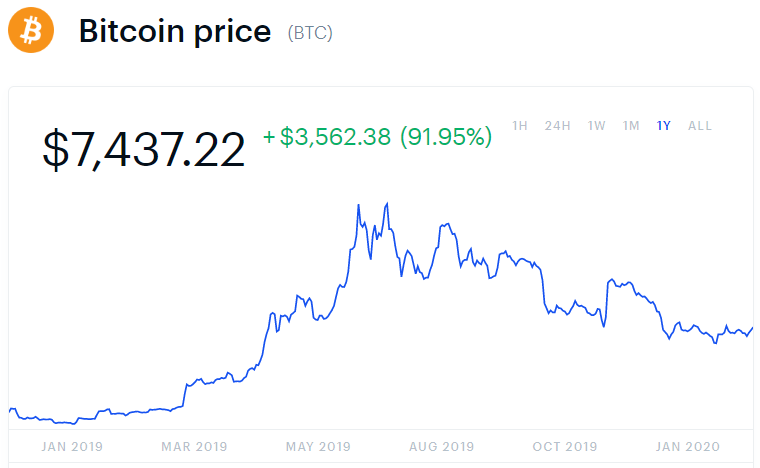Happy New Year!
I hope you got everything you wanted out of New Year’s Eve and the first few days of the new decade. I know I did. Was asleep up at my family’s cabin in the mountains by 9:15 on NYE, I finished the Wheel of time series which was FANTASTIC, Arsenal showed signs of life under our new coach, and I’ve made some significant progress on a project I am working on.
Last week I recapped some of my highs and lows from 2019. I also looked ahead and set some goals for myself. This week I will look back at the predictions I made for 2019 and come up with some thoughts about how the world is going to look a year from now.
The end of a year means prediction season. For someone who writes a (usually) weekly blog, I almost feel obligated to weigh in with my thoughts and opinions. Maybe there is so much noise it’s pointless, but I like Fred Wilson’s perspective (as I do on so many things) that it is a helpful mental exercise, especially for one who is trying to make a living by investing in the future.
So how did I do?
Surprisingly well.
In fact, I would say I pretty much killed it with my three predictions last year. I’d say my three predictions were, if not completely correct, at least directionally so. Let’s dive into each.
Prediction 1: Mega Funds take a mega hit
Let’s chalk this one up to “directionally correct”. Last year, I predicted that the VC trend of “mega funds” and the investments they made would struggle. I thought it would be the lack of performance of so clearly overcapitalized companies that would put a dent in the mega funding trend, instead most of the hits this trend were from just one company, WeWork. WeWork’s tragic 2019 combined a volatile cocktail of questionable unit economics and heinous corporate governance with a healthy dose of raging against golden parachutes to become the biggest story in all of tech last year. This is one of those events that could have long-lasting events on the industry with everyone suddenly ultra-concerned with (and equally suddenly an expert on) profitability and corporate governance. Do I think this is a bad thing? No. But I do think it is a pendulum that swings to and fro and I think there is probably a healthy balance somewhere in the middle of “grow at all costs” and “profitability before all else”. Anyways, WeWork took some serious luster off of the mega funding trend and, at the very least, seemed to have taken some of the heat out of the engine with the next SoftBank Vision fund rumored to be more focused on profits and potentially much smaller.
Prediction 2: Crypto starts showing signs of life
I am going to go ahead and say I got this one right on the money. If Bitcoin’s price is a proxy for the health/attention of the crypto market in general (which I believe it is), then it recovered nicely from the pit of late 2018/early 2019. As you’d expect from the most volatile of volatile markets, there was an overzealous recovery followed by settling back down to earth a bit. The price still ends the year at almost double what it started. Outside of Bitcoin itself, I think there are generally positive signs for the crypto/DLT industry in general. I believe we are finally seeing some cooler heads prevail and signs of early maturity from the industry. No longer are blockchain’s being strapped on to refrigerators. There seems to be an understanding from both operators and investors that crypto should only be used for use cases where the technology is absolutely necessary versus other security and database options. This has been my own personal perspective for some time and I am glad to see the sentiment growing more widespread.
Prediction 3: Tech liquidity gets weird
Last year, I predicted that there would be some mixed feelings from a liquidity perspective in the tech sector. We saw a pretty unprecedented number of big-name IPOs launch (or at least attempt to… sorry I promise I will stop talking about WeWork), but the performance of these companies once public was not much to write home about. There are a variety of explanations for this (blame WeWork, blame Warren, blame someone), but I think it largely comes down to tech darlings getting a taste of public institutional investors. In light of the FANG’s dominance over the past decade, it is easy to forget that tech companies generally stumble out of the public gates. Public investors are a lot less forgiving than private investors and focus on quarterly earnings does not always jive with the long-term growth focus of so many technology companies. I still think there is a lot of room for improvement on avenues for companies to provide access to public investors. I am glad to see some momentum around the direct listing process (great podcast with Bill Gurley on this topic here). I hope 2020 is the year that projects like the Long Term Stock Exchange pick up increased momentum as well.
2020 Predictions
Alright, time for the meat and potatoes. Without further ado, my 2020 predictions:
So Long (pre) Seed
I believe 2020 will be the year that we begin to see the “pre-seed” or “Angel” round of investing slowly go the way of the dinosaurs. Why?
Bootstrapping.
With the proliferation of easy-to-use no code tools like Notion, Squarespace, Zapier, and more it is easier than ever to build product MVPs and get them into the hands of customers. You don’t need to hire a software dev shop to build something for you. If you are willing, you can learn how to do this on your own through resources like No Code MVP and Makerpad. This ability to build the first iteration of software projects without the need for a technical background makes bootstrapping tech companies infinitely more possible than it would be just a few short years ago.
Do I really think there will no longer be any pre-seed financings?
No.
There will always be a market for early capital. But the best entrepreneurs will be able to bootstrap their companies and move straight to more established Seed or Series A rounds. This will have the massive benefits of getting their product in their customers’ hands sooner, reducing their burn rate, and cleaning up a lot of early dilution from their cap table. They will also be able to show traction earlier and have a quicker path to profitability should they choose to take it. Watch out for founders who bootstrap their way past the seed-round, these teams will be serious contenders to go all the way.
I should caveat this prediction by saying that I do not believe this holds true for all companies. Hardware and life-sciences will likely always need the earliest form of capital since it is almost impossible to bootstrap these types of companies. Even some software companies may not be able to be built this way depending on the requirements of their customers, but I still expect we will see the trend across the venture landscape as a whole.
So long pre-seed, hello bootstrapping.
Bay Area state of mind
Oh the Bay Area. The much-praised. The much-maligned. Have rumours of its demise been exaggerated? Or are its best days behind it?
I believe the answer to both of those questions is a resounding:
Yes.
You do not need to be in the Bay Area to build a venture scale business anymore. You just don’t. That debate is over and I am not even going to bother citing all the examples of companies built outside of SV because it would not be a beneficial use of our time.
So Erik, you think the Bay Area has lost its top spot as a tech hub?
Not by a long-shot.
For all the challenges it faces, the Bay Area still has the world’s strongest network effects that make it primed to build technology companies. The best investors are based there. The best engineers are based there. The best tech talent pipelines are based there. The region is so far ahead of everyone else that no one even has a chance of catching up. There will be no “next Silicon Valley.” Period.
But I do not believe that it will always be the same business as usual in the Bay Area. The costs are too high. I predict we will see more and more companies maintain a presence in SV while moving mid and back offices jobs elsewhere. This prediction is cheating a bit because I would argue this is already happening, I believe we will see more and more companies maintain an office or headquarter in the Bay Area while moving significant headquarters to other parts of the country with lower costs of living and higher standards of living. This way they are able to capture the network effects of the valley, without being exposed to so many of its downsides. It’s the best of both worlds.
The rise of micropreneurship
A common theme on this blog has been my belief that it has never been easier to start a business. The tools, resources, and knowledge are all out there if you are willing to look (and do a bit of googling). This new era of accessibility to entrepreneurship is having massive impacts on the world of venture capital, but I believe that 2020 will be the year it truly begins to affect main street as well. People want to build something of their own. They want the flexibility that remote work and entrepreneurship can offer. And now they finally have the tools to build their own small businesses. Maybe these are side gigs for some extra income. Maybe these are full-time pursuits. Ecommerce. Streaming. Instagram pages. Podcasts. Blogs. Online advertising. The beauty is that this new trend of “micropreneurship” could look different to everyone.
The downside?
There are no longer any excuses. If you want to build something, go build it. If you are willing to put in the time and effort, you have all the tools you need just a few short keystrokes away.
Here's to another year of ups and downs (but hopefully more ups than downs)!




